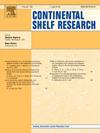Spatial variation of marine primary productivity over ridge and trough: A case study in the East China Sea
IF 2.2
3区 地球科学
Q2 OCEANOGRAPHY
引用次数: 0
Abstract
Tidal sand ridges are widespread in continental shelves and have attracted much attention due to their effects on ecology, geochemistry, and hydrodynamics. Typical tidal sand ridges are widely distributed throughout the East China Sea (ECS). Previous studies proposed that marine primary productivity (MPP) displays different spatial variations in ridges and troughs. Chlorophyll-a (Chl-a) and total organic carbon (TOC) are effective proxies for MPP. This study examined the influence of topography on MPP. The data analyzed included the Chl-a product from Himawari-9 and TOC and stable organic carbon isotopic compositions from surface samples in the ECS. Our results demonstrate that Chl-a displays an alternating pattern of significant fluctuations in the ECS. Chl-a concentrations in the ridge were higher than those in the trough and exhibited different characteristics at the surface and bottom of the water column. Biogeochemical parameters showed significant differences between ridges and troughs. Suspended particulate matter (SPM) and median particle size (D50) in the ridges were finer than those in the troughs, indicating that fine particulates are beneficial for the enrichment and adsorption of organic carbon, which is consistent with TOC data. The C/N and δ13C data indicate that the organic matter in our study area originates from terrestrial and marine sources. According to the N/C calculation results, the proportion of marine organic carbon is higher on the ridge. Moreover, the temperature and nutrients, as the dominant factors affecting MPP, appear to vary in ridges and troughs. Understanding the effects of topography is important for clarifying the distribution of phytoplankton and predicting marine biological disasters.
海槽和海脊海洋初级生产力的空间变异——以东海为例
潮沙脊在大陆架中分布广泛,对生态、地球化学和水动力学具有重要影响。典型的潮沙脊在东海广泛分布。以往的研究表明,海洋初级生产力(MPP)在海脊和海槽中表现出不同的空间变化。叶绿素a (Chl-a)和总有机碳(TOC)是MPP的有效指标。本研究考察了地形对MPP的影响。分析的数据包括Himawari-9的Chl-a产物和ECS表面样品的TOC和稳定有机碳同位素组成。我们的研究结果表明,Chl-a在ECS中表现出显著波动的交替模式。脊区Chl-a浓度高于槽区,且在水柱表面和底部表现出不同的特征。生物地球化学参数在海脊和海槽间存在显著差异。脊状带的悬浮颗粒物(SPM)和中位粒径(D50)均小于槽状带,表明细颗粒物有利于有机碳的富集和吸附,这与TOC数据一致。C/N和δ13C数据表明,研究区有机质来源于陆相和海相。根据N/C计算结果,海相有机碳在海脊的比例较高。此外,温度和养分作为影响MPP的主要因素,在脊槽中表现出差异。了解地形的影响对厘清浮游植物的分布和预测海洋生物灾害具有重要意义。
本文章由计算机程序翻译,如有差异,请以英文原文为准。
求助全文
约1分钟内获得全文
求助全文
来源期刊

Continental Shelf Research
地学-海洋学
CiteScore
4.30
自引率
4.30%
发文量
136
审稿时长
6.1 months
期刊介绍:
Continental Shelf Research publishes articles dealing with the biological, chemical, geological and physical oceanography of the shallow marine environment, from coastal and estuarine waters out to the shelf break. The continental shelf is a critical environment within the land-ocean continuum, and many processes, functions and problems in the continental shelf are driven by terrestrial inputs transported through the rivers and estuaries to the coastal and continental shelf areas. Manuscripts that deal with these topics must make a clear link to the continental shelf. Examples of research areas include:
Physical sedimentology and geomorphology
Geochemistry of the coastal ocean (inorganic and organic)
Marine environment and anthropogenic effects
Interaction of physical dynamics with natural and manmade shoreline features
Benthic, phytoplankton and zooplankton ecology
Coastal water and sediment quality, and ecosystem health
Benthic-pelagic coupling (physical and biogeochemical)
Interactions between physical dynamics (waves, currents, mixing, etc.) and biogeochemical cycles
Estuarine, coastal and shelf sea modelling and process studies.
 求助内容:
求助内容: 应助结果提醒方式:
应助结果提醒方式:


